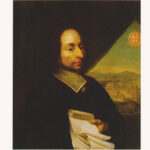The French mathematician and physicist, Blaise Pascal was born in Clermont -Ferrand in central France on June 19th, 1623. In 1621 his mother passed away and he and his two sisters Gilberte and Etienne, and their father were forced to move to France in 1631. Blaise did not attend and University, he was schooled by his father; he was what you would call a child prodigy.
His father wanted to keep him confined to learning languages. But the boy’s curiosity got the best of him. At the age of 12 he started asking what Geometry consisted of and eventually by himself he figure out proposition of Euclidean geometry. When he was 14 years of age he was sent to meeting that were held weekly by Roberval, Mersenne, Mydorge, and other French geometricians.
Around the time he was 17, he wrote an essay on Conic Sections. At the young age of 16 Pascal came up with the “Pascal Theorem” which was formulated for projective geometry. This was eventually named after him.
When Pascal was around the age of 18 he had invented the first adding machine which is know today as the calculator. It was done by a hand-crank. Later in the 18th and the 19th century the adding machine was improved, then in the 20th century computers did the math. He invented this when his father was appointed representative for the king in Normandy and there was a great deal of finical matters and he figured this would help.
Later Pascal came up with a law called Pascal’s law. This law states that a fluid sends pressures equally all throughout and in all directions. He came up with this law after he proved to other mathematicians that the level of the mercury column in a barometer is determined by the increase or decrease in the pressure surrounding. In 1650 he started to lose interest in what he loved the most to pursue religion. Around the same time as this he talked the youngest of his sisters to enroll in the Port Royal Society, Where later on she became a nun part of this society.
In 1650 Pascal became involved with a religious movement in France know as Jansenism. He put quickly abandoned what he loved the most to pursue the study of religion.
Pascal returned once again to Paris in 1647 for his father’s second retirement. After a mysterious experience one night that had occurred on November 23-24, 1654, he had a conversion, and defended Jansenism against the Jesuits in Provincial Letters. From 1655 he made occasional returns to Port-Royal des Champs. Pascal worked on a transportation system for Paris in 1660-1662.
In 1653 he had to take up his old life again because he to administer his fathers estate. He started testing with pressure exhorted by gases; it was also in this time period when he wrote the “Treatment of the Arithmetical Triangle.” Also know as Pascal’s Triangle. He began to influence mathematics again.
Pascal started to use his “arithmetical triangle” in the early 1653’s but there wasn’t and copies of this method printed until the year 1655. The triangle is set up with horizontal line being created from the one above it by creating every number in it equal to the sum of those ones above.
To make it more simple Pascal’s triangle can be set up in this formation. In the first row write the number 1. Then to complete the following rows, add the number above to the left and the number above to the number on the right to find the new value. If there is no number to the left or too the right substitute a zero in its place.
The last of Pascal’s mathematical work had to do with the Cycloid. This is the curve traced out by a point located in the circumference of a hoop with travels alone a straight line. Galileo had called attention to this curve in 1630 which this shape is particularly graceful, and suggest that bridges and arches and this of this such should be built in this form. In 1634, 4 years later Roberval also had found the area of the Cycloid. The same challenge was also sent to Fermat who at once solved the problem.
He had injured his overall health by his need to study all the time; from when he was at the age of 17-18 he suffered from insomnia and what some believe a stomach ulcer There were many problems that lead up to this. He also had very poor circulation and was forced to wear stocking to keep his feet warm. These illnesses crippled him and he was not able to walk without the assistance of crutches by his side.
He then moved to his sisters house hoping she would be able to aid him and take care of him and in 1662 he had worn him self out completely where he died in Paris France in one of his sisters houses on August 19th, 1662.


